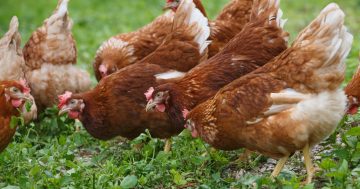Andrew Suggitt* says the latest outbreak of avian flu is a now global problem as it has jumped from chickens to wild birds and is spreading fast.
 After a series of localised outbreaks in the past few years, avian flu has re-emerged as a major driver of bird deaths across the United Kingdom.
After a series of localised outbreaks in the past few years, avian flu has re-emerged as a major driver of bird deaths across the United Kingdom.
Until the past few weeks, the latest outbreak of the disease — also known as bird flu or, to scientists, highly pathogenic avian influenza — was treated primarily as a problem for chickens and other domestic birds.
This triggered localised responses such as culls, and farmers were ordered to keep their animals indoors for six months over the winter.
However, reports of large numbers of wild seabirds found dead in Scotland, and increasingly in England and Wales, suggest that avian flu is now prevalent in wild birds across most of northern Britain.
I encountered a number of these birds on the Northumberland coast.
This latest outbreak is a global problem, with cases of the virulent H5N1 subtype detected in West Africa, Asia, and nearly every country of Europe and North America.
It is primarily a disease of domesticated birds, where it is thought to have originated, and has led to the culling of hundreds of millions of birds, including 38 million in the United States this year alone.
In the UK, the disease was first detected in October 2021. As elsewhere, the outbreak was at first largely confined to poultry, and farmers were forced to cull 500,000 chickens and other birds.
In response, the UK established an Avian Influenza Prevention Zone, including buffer zones of 10 kilometres around detected cases, with restrictions on bird movement and enhanced biosecurity.
Over the northern winter there were reports of a number of wild bird populations being affected by avian flu, including great skua, pink-footed geese and barnacle geese.
These included the mass death of 4,000 birds on the Solway Firth, representing one-third of the Svalbard barnacle goose population that spend winters in the area.
As spring has turned to summer, there is now no doubt that avian flu is spreading into a wider diversity of wild birds in the UK.
For some species this probably reflects their return to summer breeding colonies, and the increased mixing that involves (avian flu is spread by contact with saliva or droppings).
As this breeding season reaches its peak, a wide array of seabirds have been affected, including great skua, eider ducks, fulmar, terns, gannets and guillemots.
The UK holds more than half the world’s population of gannet and great skua, both of which have been officially recognised as birds of moderate conservation concern.
Avian flu adds to the litany of problems these birds face, from climate change to entanglement in abandoned fishing gear, and increases the concerns of organisations who already consider this outbreak to be the worst the UK has ever faced.
Conservation organisations have asked for more resources to help with monitoring and tackling the problem.
Many bird wardens and reserve managers already work on the nature reserves most affected by avian flu, and so will be an important part of the solution.
We could also reduce the level of human disturbance at particularly sensitive sites, for example by introducing buffer zones or seasonal restrictions.
More broadly, we need more surveillance of avian flu so that we can get a better idea of the problem.
This will mean giving the relevant Government Agencies the resources they need to monitor and test more wild birds.
In summer, avian flu retains infectivity in the environment for up to 18 days.
The large number of dead birds on the coast with possible infections presents a continuing pathway for transmission to birds of prey and carrion feeders, particularly gulls, which are known to be susceptible to avian flu.
Increasing the number of carcasses being collected would have the added benefit of removing the potential for carrion feeders to become infected, and so further infect other birds.
Given some of these seabirds can range over huge distances in search of food — up to 400 kilometres for gannets, for instance — we will need coordination across the four nations of the UK.
Because the virus has been repeatedly transmitted between the domestic stocks and wild bird populations, we should also look again at biosecurity measures in the poultry industry.
Although avian flu is a zoonotic disease like COVID-19, the risk to human health is very low, and cases in humans have almost exclusively arisen from close contact between bird keepers and their stock.
The advice for the public is not to touch any dead birds and to report them.
Those who feed wild birds should remember to wash and disinfect feeders every week and clean bird baths every day.
Dog walkers should keep a closer eye on their animals if they are on the beach or by water.
There is no doubt that the increased visibility of the deaths will bring home the scale of the problem to the general public.
Bird flu has now ‘arrived’ in our minds, and will take on more prominence as the summer continues and holidays begin.
It serves as another reminder of how connected we are to nature, and how our interactions with the natural world have huge consequences for what we regard as ‘human’ systems.
*Andrew Suggitt is a Vice Chancellor’s Senior Research Fellow in the Department of Geography and Environmental Sciences at Northumbria University. His research examines the effects of environmental change on the natural world.
This article first appeared on The Conversation UK website.




